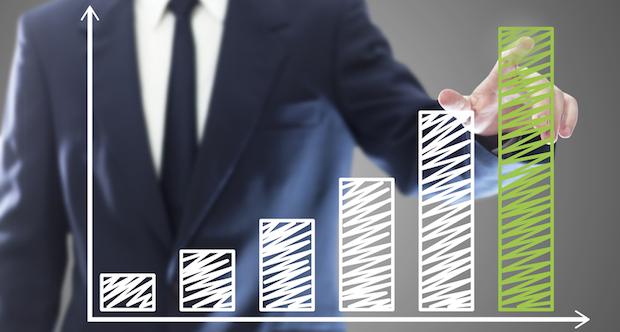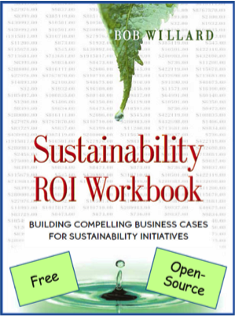
By Bob Willard
I just released the Sustainability ROI Workbook. It is a self-published, free, open- source Excel workbook with the most comprehensive business case for sustainability so far. My “mission impossible” goal is that by the end of 2018, the global legions of sustainability champions are aware of, and can use, a version of the Sustainability ROI Workbook as their go-to business case tool, so that they can gain approval from their CEOs and CFOs to take action on pressing sustainability initiatives. Here is the back story to the workbook and that BHAG.
source Excel workbook with the most comprehensive business case for sustainability so far. My “mission impossible” goal is that by the end of 2018, the global legions of sustainability champions are aware of, and can use, a version of the Sustainability ROI Workbook as their go-to business case tool, so that they can gain approval from their CEOs and CFOs to take action on pressing sustainability initiatives. Here is the back story to the workbook and that BHAG.
I am a late-bloomer in the sustainability scene. I woke up in the mid-90s to the deteriorating state of the world. As I learned in ensuing masters and doctoral studies, pressing environmental and social issues require urgent action, especially climate destabilization. I gradually realized that we collectively know what needs to be done and we know how to do it. What is missing the will to do it.
I have two adult sons and an adult daughter. I have three young grandsons. I want to ensure that the world they inherit affords them the opportunity to enjoy a quality of life that is at least as good as I have enjoyed. My will / justification for sustainability action is a no-brainer.
Corporations have the intelligence, resources, and influence to help us reach the necessary science-based sustainability goals before it is too late … if they have the will to do so. We need existing businesses to want to improve their sustainability performance, especially large corporations who have enormous influence on every facet of human society. Of course, they need a compelling justification for being more proactive, just as they need a compelling justification before undertaking any major investment or initiative. Despite extensive research in the late-90s, I couldn’t find a good sustainability business case calculator to help with that justification, so I decided to take early retirement from IBM and create one.
That resulted in my first book, The Sustainability Advantage (2002) and its companion spreadsheets. On its 10th anniversary, I rewrote and recalibrated the business case and wrote The New Sustainability Advantage (2010) and its companion spreadsheets. It shows that if a typical company were to use best-practice sustainability approaches already being used by real companies, it could improve its profit by at least 51% to 81% within three to five years, while avoiding a potential 16% to 36% erosion of profits if it did nothing. And those are low ball, conservative estimates. There was now a profit-based business case calculator for doing more on the environmental and social fronts.
However, I still saw studies that found that companies agree that they need to improve their sustainability performance but cant’t justify doing so. The latest report is “Corporate Sustainability at a Crossroads: Progress Toward Our Common Future in Uncertain Times,” by the MIT Sloan Management Review and The Boston Consulting Group, published in May 2017. Here are three findings from its eight-year corporate sustainability research effort based on survey responses from more than 60,000 business practitioners at global companies and more than 150 thought-leader interviews:
- Companies that focus on material issues reported up to 50% added profit from sustainability activities, compared to those that do not.
- Building sustainability into business units can double an organization’s chance of profiting from its sustainability activities.
- 90% of executives surveyed believe sustainability is important. However, 60% of companies have a sustainability strategy and only 25% have developed a clear business case for their sustainability efforts (my italics).
It seems that we have not been very good at providing that “clear business case” after all. In November 2016, Bain & Company published a rather shocking report. Based on a survey of over 300 large companies engaged in sustainability efforts, it found that 98% of sustainability initiatives fail. Why? Because they do not have CEO / CFO support. Why not? Because they lack of a compelling business case. Executives won’t / can’t support a project unless they are convinced that it will be good for the company, as well as good for the environment and society. That’s what a good business case helps them see.
These were strong hints that my business case framework lacked some important components. So, I talked with CPAs about what a good business case for any capital expenditure should include, studied the “HBR Guide to Building Your Business Case,” and took a “Business Case Writing” course. They all emphasized the importance of a multi-year cost-benefit analysis that helped assess the payback period and return on investment (ROI) for any proposed initiative. The New Sustainability Advantage had shied away from those calculations to avoid overwhelming less financially literate sustainability professionals. Now I knew that leaving out those factors was a disservice, not a kindness.

I also researched 15-20 other sustainability business case frameworks to ensure that I was not overlooking potential business case elements that could benefit directly or indirectly from sustainability There were a few, like activation of the company purpose, increased asset values, increased market value, and savings in a few operational expense areas that were not in my previous business cases. I synthesized them into a comprehensive superset of all the financial line items that could be directly or indirectly improved by sustainability initiatives, organized around the three big justifications used by companies to support any significant undertaking. All fil-in-the blank cells have extensive pop-up guidance about possible benefits arising from the sustainability initiative, based on other companies’ experience.
The framework meets executives where they are and honors their need for compelling ROI information when they assess proposals. If an initiative improves the company’s reputation, grows revenue, saves expenses, engages employees, helps win the war for talent, spurs innovation, meets company norms for payback periods, provides a good internal return on investment, increases the value of company assets, and / or contributes to higher share prices, of course executives will support it.
Sustainability ROI Workbook is a “book” cleverly disguised as an Excel workbook. The comprehensive, fill-in-the-blanks Excel workbook is the e-book. It does the ROI and payback period for users, based on their input. It can be used to build business cases for one or several sustainability initiatives, for the whole company or one location or business function.
To expedite its use by global legions of sustainability champions, it is a self-published, free, open-source resource downloadable from sustainabilityadvantage.com. Others are encouraged to use it as a foundation on which to create additional tailored versions for specific sectors or users, for other technology platforms, in other languages, and in simpler formats.
My hope is that the resource will be fully exploited as a catalyst to building a critical mass of leading companies who prosper through their sustainability efforts and pick up the pace in the sustainability race. If a version of the tool were in the toolkits of the global legions of sustainability champions, they can help convince the business community to do what needs to be done on critical sustainability issues, in time. It would help them see that action is in their self-interest, as well as in the interest of my grandchildren.
____________

Bob is a leading expert on quantifying and selling the business value of corporate sustainability strategies and has given over a thousand presentations to corporate, government, university, and NGO audiences. Bob applies his business and leadership experience from his 34-year career at IBM Canada to engage the business community in proactively avoiding risks and capturing opportunities by using smart environmental, social, and governance (ESG) strategies. He has authored six books: The Sustainability Advantage (2002), The Next Sustainability Wave (2005), The Sustainability Champion’s Guidebook (2009), ), The New Sustainability Advantage (2012), Future-Fit Business Benchmark (co-authored, 2016), and Sustainability ROI Workbook (2017). In addition, his two DVDs, free open-source business case simulators, and extensive Master Slide Set provide capacity-building resources for sustainability champions.
